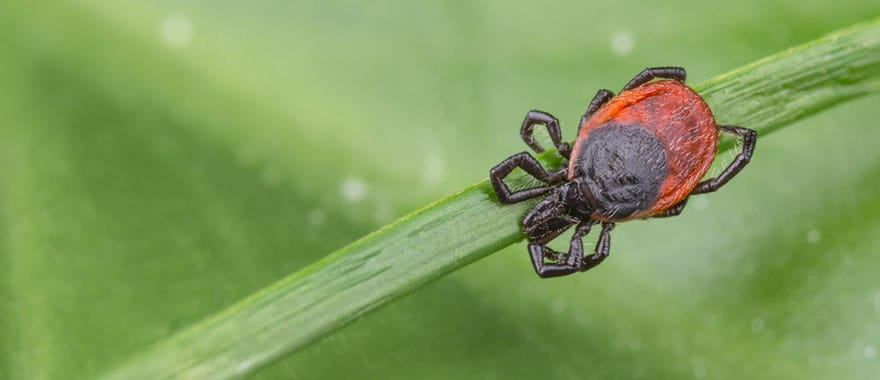Trees are essential to our world, offering a wide range of benefits to our environment. However, trees become hazardous liabilities if they fall and injure people or damage property. Proper constant maintenance will help prevent and identify when a tree becomes dangerous.
What to Look For
High-risk defects are signs that a tree is failing. Look for seven important tree defects: dead wood, cracks, weak branch unions, decay, cankers, root problems, and poor tree form. These tree defects will be described in the next several sections.
Remember: a tree with defects is not hazardous unless some portion of it is within striking distance of a target.
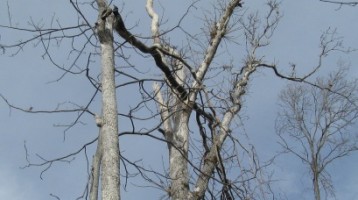
Very dangerous dead branch hanging in tree otherwise known as a widow maker
#1 – Dead Wood
Dead trees and branches are unpredictable and can break and fall at any time. Dead wood is often dry and brittle and cannot bend in the wind like a living tree or branch. A dead branch and treetop that is already broken off (a “hanger” or “widow maker”) is especially dangerous.
Act immediately if . . .
• A broken branch or treetop is lodged in a tree.
• A tree is dead.
• A branch is dead and of sufficient size to cause injury. Typically this is a branch larger than 4 inches in diameter, but this can vary with branch height. Even smaller branches, falling from high in the tree, can cause serious personal injury.
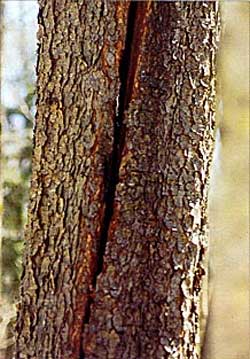
Often, cracks can easily be seen in the tree bark
#2 – Cracks
A crack is a deep split through the bark, extending into the wood of the tree. Cracks are extremely dangerous because they indicate that the tree is already failing.
Act immediately if . . .
• A crack extends deeply into, or completely through the stem.
• Two or more cracks occur in the same general area of the stem.
• A crack is in contact with another defect.
• A branch of sufficient size to cause injury is cracked (typically larger than 4 inches in diameter).
#3 – Weak Branch Unions
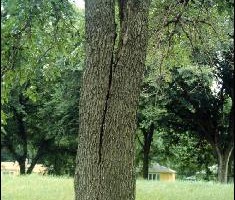
This crack is a high hazard situation caused by two main trunks on one tree
Weak branch unions are places where branches are not strongly attached to the tree. A weak union occurs when two or more branches grow so closely together that bark grows between the branches and inside the union. This ingrown bark, called “Included bark” does not have the structural strength of wood and the union can become very weak. The inside bark may also act as a wedge and force the branch union to split apart. Trees with a tendency to form upright branches, such as elm and maple, often produce weak branch unions.
Act immediately if . . .
• A weak branch union occurs on the main stem.
• A weak branch union is associated with a crack, cavity, or other defect.
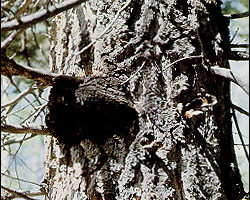
Tree with conch decay fungus
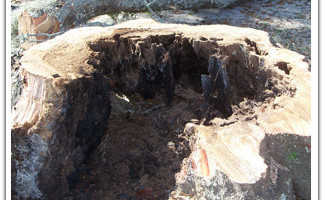
Trunk rot
#4 – Decay
Decaying trees are prone to failure, but the presence of decay alone does not necessarily mean failure. Still, advanced decay (soft, crumbly wood with a cavity) is serious. Evidence of fungal activity including mushrooms and conks are indicators of advanced decay. Decay is very common on the majority of large maple trees we have in Connecticut because of their large size and structure. A tree usually decays from the inside out, forming a cavity, but sound wood is added to the outside of the tree as it grows. Trees with sound outer wood shells are relatively safe. Still, evaluating the safety of a decaying tree is usually best left to trained arborists.
Act immediately if . . .
• Advanced decay is associated with cracks, weak branch unions, or other defects.
• A large branch is decayed.
• The thickness of sound wood is less than 1 inch for every 6 inches of diameter, at any point on the stem.
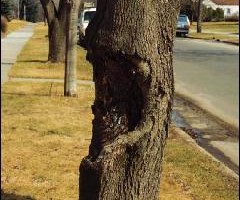
This large canker most likely caused from an impact with the trunk can seriously weaken the trunk.
#5 – Canker
A canker is a localized area on a stem or branch of a tree, where bark is sunken or missing. Cankers are caused by wounding or disease. The presence of a large canker increases the chance of the stem or branch breaking near the canker.
Act immediately if…
• A canker affects more than half of the tree’s circumference.
• A canker is physically connected to a crack, weak branch union or cavity.
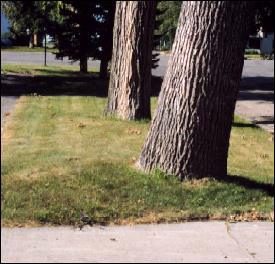
The mound at the base of this tree indicates that the tree has recently begun to lean, and may soon fail.
#6 – Roots
Trees with root problems may blow over in windstorms or even fall from the weight of the tree’s leaves in summer. Root problems can be caused by severing or paving-over roots; raising or lowering the soil depth over roots; traffic over the roots; or root decay. Dieback, dead wood in the crown and off-color or smaller than normal leaves are symptoms associated with root problems. These above ground symptoms may serve as your best warning.
Act immediately if. . .
• A tree is leaning with recent root exposure, soil movement, or soil mounding near the base of the tree.
• More than half of the roots under the tree’s crown have been cut or crushed.
• Advanced decay is present in the root flares or buttress roots.
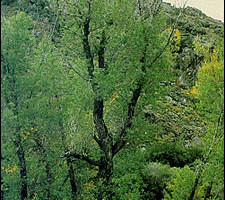
This tree is decayed and badly out of balance because of poor maintenance. It is dangerous, and extremely unattractive!
#7 – Poor Tree Form
Trees with strange shapes are interesting to look at, but may be structurally defective. Poor tree form often results from many years of damage from storms, unusual growing conditions, improper pruning, topping, and other damage.
Act immediately if . . .
• A tree leans excessively.
• A large branch is out of proportion with the rest of the crown.
A high-risk situation increases as your tree defects increase!
Finding multiple defects in a tree should be your red flag when evaluating its potential to fail. Multiple defects that are touching or are close to one another should be carefully examined. If more than one serious defect occurs on the tree’s main stem, you should assume that the tree poses a very high level of risk and corrective actions should be taken.
If a high-risk situation exists, there are four recommended options for correcting the problem:
- move the target
- prune the tree
- convert the tree to a wildlife tree or
- remove the tree
Moving the target is often an inexpensive, effective, and simple treatment for correcting a high-risk tree. Easily moved items like play sets and swings, vehicles, and picnic tables can be placed out of the reach of the hazardous tree with little effort and expense. If the target cannot be moved and a high-risk situation exists, consider blocking access to the target area until the hazard can be eliminated.
Consider Corrective Action
Practicing proper tree pruning is excellent preventive medicine!
A defective branch or branches may cause a high-risk situation, even though the rest of the tree is sound. In this case, pruning the branch or branches solves the problem. Practicing proper tree pruning is excellent “preventive medicine” for reducing the occurrence of defective, high-risk trees. By pruning properly, early in a tree’s life, you can prevent or correct many of the problems that cause trees to fail as they mature. Improper pruning techniques can worsen the problem, and may ultimately result in the formation of cracks, decay, cankers, or poor tree architecture that lead to very high risk situations. (Click here for more information on pruning)
Creating Wildlife Habitat
This corrective action is often overlooked. Corrective actions should be selected with safety in mind while preserving a portion of the tree intact to provide wildlife habitat. One option is to reduce the height of a tree to the point that it would no longer strike a target if it should fail. Remove major branches that are defective, and leaving a portion of the tree intact for wildlife habitat. If a tree must be removed for safety reasons, consider leaving the tree on ground to create wildlife habitat.
Remove the Tree
Before removing a tree, carefully consider whether the effects of removing the tree could result in reduced property values. Tree removal should be considered as the final option and used only when the other corrective actions will not work. Tree removal is inherently dangerous and is even more serious when homes and other targets are involved. Removal of very high-risk trees is usually a job for a professional.
Cabling and Bracing
Cabling and bracing do not eliminate all the safety risks associated with a highly defective tree, but when done correctly by a trained arborist, it can extend the time a tree or its parts are safe. Done incorrectly, it creates a more serious hazard. Cabling or bracing is not recommended for a high-risk tree unless the tree has significant historic or landscape value, the cabling or bracing is done by a trained professional, is regularly inspected, and properly maintained.
Conclusion
Evaluating and treating tree hazards can be a complicated process, requiring a certain level of knowledge and expertise. I have outlined some of the basic problems that may alert you to a hazardous situation, and suggest some possible ways to correct them.
A professional should be consulted when undertaking many of the suggested corrective actions. When in doubt about how much risk a defective tree poses, or how to best treat it, consult with a professional like Barts Tree Service.
Remember that trees do not live forever. Design and follow a backyard landscape plan that includes proper tree selection and a cycle of tree maintenance and replacement. This is the best way to preserve the health of your trees and ensure a safe and enjoyable outdoor experience.



